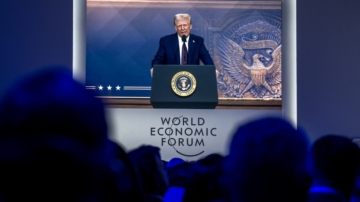【新唐人2011年9月22日讯】三年前爆发的全球金融海啸,中国顺利的躲过风暴,并在紧缩货币政策下,不少国企变身“影子银行”。随着贷款期限的到来,近期爆发了一连串的高利贷崩盘事件,外媒警告,中国版“次贷危机”即将上演。
2008年全球金融海啸爆发后,中国开始实施紧缩政策,中小企借贷无门,不少国企成了资金的提供者,这些国企从官方银行系统取得资金后,转手再贷出,为企业注入了可观的利息收益。除此之外,非官方影子银行规模的扩大,也让问题不断暴露出来。经济学家担心中国恐爆发次贷危机。
上周在大连举行的世界经济论坛(World Economic Forum)上,原全国人民代表大会常务委员会副委员长的成思危语出惊人说,“中国版的美国次贷危机是把钱借给了没有还款能力的地方政府。”
据估计,中国四大银行多达80%的贷款是贷给了国有企业。而中国目前有多种形式的“影子银行”,从国企、民间担保机构到个人,多有官方背景。贷款成为了地方政府的投资方式,资金规模估计多达1.7万亿美元。
可怕的是,这些“影子银行”都是不受监管或少受监管的非银行金融机构。
经济评论家草庵居士表示,一些国企拥有资金的优势,透过一些平台或担保公司向外放贷,在缺乏信用体制下,这问题一旦爆发将会比美国次贷更加严重。
草庵居士:“现在经济整个萎缩情况下,中国这些大量需要钱的中小型企业,这个钱借出去之后呢,很难有企业能够有这个60%到100%利润,这个讲白了就是一个非常大的风险,这种情况尤其一些企业,他的想法是:我能借到钱度过难关我就能维持下去了,如果维持不下去我可以跑掉。”
中国新增贷款占新增国内生产总值的比例,从雷曼兄弟倒闭前的不到100%增加到今天的200%左右。而不良贷款率也从2010年上半年的1%大幅上升到2011年上半年的 4.9%。
纽约(城市)市立大学经济学教授陈志飞指出,很多专家分析,今年(2011年)是私人企业自改革开放以来最难过的一年,根据工商联做的调查,90%的中国企业没有拿到银行的一分钱,95%的私人微型企业也拿不到银行的贷款,这是国家资金分配不合理的现象。
陈志飞:“中国这种资金分配是国有的资金政策,它已经成型了十几二十年,尤其在金融危机发生之后有四万亿的投入,就是说如果他的回报拿不到他的成本的话,我觉得这个危机造成很多银行,会面临坏帐,和国家整个经济活动崩溃有这个危险。”
北京经济学者茅于轼表示,中国四大银行是国家管制的银行,但还是发生了几万亿的不良贷款。
茅于轼:“企业从银行借了钱然后转手去放高利贷,问题就是因为我们利息不是市场化,它是官僚化的,它是有特权的人可以借钱,一般人借不到,只能借高利贷,这问题就在这。”
茅于轼表示,要解决这个问题,就是开放中小银行,让老百姓办银行,不要国家垄断。
新唐人记者梁欣、李庭、王明宇采访报导。
China’s Subprime Mortgage Crash
The Global Financial Crisis (GFC) started three years ago,
but China seems to be immune to it.
Under the tightening monetary policy,
many of enterprises are turning into shadow banks.
With the due date of loan sharking approaching,
the economic claps occur continuously.
Foreign media warned that the Chinese version
of the Subprime Mortgage Crash is approaching.
After the start of the GFC in 2008,
China began changing its monetary policy.
For small and medium size firms its difficult
to access the formal banking sector.
Instead, they loan money from shadow lenders
who are actually state companies.
The official sector can obtain money from state-owned banks
and issue loans to other borrowers with higher interest rates.
In addition, non state-owned shadow banks are expanding,
and more problems are being exposed.
Economists are worried that China is starting to follow
the pattern of the U.S.’ Subprime Mortgage Crash.
During the World Economic Forum held in Dalian last week,
a former vice chairman of NPC, Cheng Siwei said:
"China’s Subprime Mortgage Crash is the lending of money
to local governments which have no ability to repay them."
It is estimated that 80% of the loans from the top four banks
in China go to state-owned firms.
But now China has different shadow banks, from state-owned
to individuals’ firm, most of them with officials’ background.
Local governments use state funds to invest in businesses,
and the funds are estimated to be ca. $1.7 trillion.
These shadow banks are outside the banking and financial
sectors and are thus less regulated or not regulated at all.
Economist Cao An thinks that the state-owned firms
have the advantage of funds.
They can lend the money through guarantee companies
or other platforms.
In this lack of credit system, once the problem is exposed,
it will be worse than what happened in the U.S.
Cao An: "The economic trend is at a low point,
small or medium-sized firms need plenty of funds.
But even with the loans it is difficult for them to make
60-100% profit and service the loan; this is a risk for lenders.
Therefore if the borrowers fail to service and repay the loans,
this will become a bad debt."
China added new loans, adjusted to its GDP. They went up
to 200%, from 100% prior to Lehman Brothers’ collapse.
Subsequently, the bad debt rate raised
from 1% in the first half of 2010 to 4.9% in 2011.
Chen Zhifei, Economy Professor, New York City University,
points out experts’ analysis,
which shows 2011 as the most difficult year for China
since China’s open market economy had started.
According to a survey done by the Industrial Federation,
90% of the firms in China don’t get a penny from the banks,
and 95% of the private firms don’t get loans from banks
either, showing that funds allocation is not sound.
Chen Zhifei: "China’s fund distribution is for state-owned
enterprises, This policy exists for 10 to 20 years now.
After the GFC started, China had loaned
RMB 4 trillion for investments.
If these investments’ loans do not get repaid, they will turn
into bad debts and the country’s economy will collapse."
Beijing economist Mao Yushi points out that although
the top four banks in China are controlled by the government, the accumulation of bad debts still occurs
Mao Yushi: "The companies borrow money from the banks
and lend them as high interest rate loans.
The problem is due to lack of interest rates’ market regulation.
It’s bureaucratic as it’s the privileged who can borrow money.
Most of the people can only borrow high interest rate loans,
this is the reason why the problem exists for so long."
Mao Yushi thinks that the solution to these problems
is to open small and medium-sized banks,
and let people establish such banks as well,
not only the government.
NTD reporters Liang Xi, Li Ting and Wang Mingyu.
2008年全球金融海啸爆发后,中国开始实施紧缩政策,中小企借贷无门,不少国企成了资金的提供者,这些国企从官方银行系统取得资金后,转手再贷出,为企业注入了可观的利息收益。除此之外,非官方影子银行规模的扩大,也让问题不断暴露出来。经济学家担心中国恐爆发次贷危机。
上周在大连举行的世界经济论坛(World Economic Forum)上,原全国人民代表大会常务委员会副委员长的成思危语出惊人说,“中国版的美国次贷危机是把钱借给了没有还款能力的地方政府。”
据估计,中国四大银行多达80%的贷款是贷给了国有企业。而中国目前有多种形式的“影子银行”,从国企、民间担保机构到个人,多有官方背景。贷款成为了地方政府的投资方式,资金规模估计多达1.7万亿美元。
可怕的是,这些“影子银行”都是不受监管或少受监管的非银行金融机构。
经济评论家草庵居士表示,一些国企拥有资金的优势,透过一些平台或担保公司向外放贷,在缺乏信用体制下,这问题一旦爆发将会比美国次贷更加严重。
草庵居士:“现在经济整个萎缩情况下,中国这些大量需要钱的中小型企业,这个钱借出去之后呢,很难有企业能够有这个60%到100%利润,这个讲白了就是一个非常大的风险,这种情况尤其一些企业,他的想法是:我能借到钱度过难关我就能维持下去了,如果维持不下去我可以跑掉。”
中国新增贷款占新增国内生产总值的比例,从雷曼兄弟倒闭前的不到100%增加到今天的200%左右。而不良贷款率也从2010年上半年的1%大幅上升到2011年上半年的 4.9%。
纽约(城市)市立大学经济学教授陈志飞指出,很多专家分析,今年(2011年)是私人企业自改革开放以来最难过的一年,根据工商联做的调查,90%的中国企业没有拿到银行的一分钱,95%的私人微型企业也拿不到银行的贷款,这是国家资金分配不合理的现象。
陈志飞:“中国这种资金分配是国有的资金政策,它已经成型了十几二十年,尤其在金融危机发生之后有四万亿的投入,就是说如果他的回报拿不到他的成本的话,我觉得这个危机造成很多银行,会面临坏帐,和国家整个经济活动崩溃有这个危险。”
北京经济学者茅于轼表示,中国四大银行是国家管制的银行,但还是发生了几万亿的不良贷款。
茅于轼:“企业从银行借了钱然后转手去放高利贷,问题就是因为我们利息不是市场化,它是官僚化的,它是有特权的人可以借钱,一般人借不到,只能借高利贷,这问题就在这。”
茅于轼表示,要解决这个问题,就是开放中小银行,让老百姓办银行,不要国家垄断。
新唐人记者梁欣、李庭、王明宇采访报导。
China’s Subprime Mortgage Crash
The Global Financial Crisis (GFC) started three years ago,
but China seems to be immune to it.
Under the tightening monetary policy,
many of enterprises are turning into shadow banks.
With the due date of loan sharking approaching,
the economic claps occur continuously.
Foreign media warned that the Chinese version
of the Subprime Mortgage Crash is approaching.
After the start of the GFC in 2008,
China began changing its monetary policy.
For small and medium size firms its difficult
to access the formal banking sector.
Instead, they loan money from shadow lenders
who are actually state companies.
The official sector can obtain money from state-owned banks
and issue loans to other borrowers with higher interest rates.
In addition, non state-owned shadow banks are expanding,
and more problems are being exposed.
Economists are worried that China is starting to follow
the pattern of the U.S.’ Subprime Mortgage Crash.
During the World Economic Forum held in Dalian last week,
a former vice chairman of NPC, Cheng Siwei said:
"China’s Subprime Mortgage Crash is the lending of money
to local governments which have no ability to repay them."
It is estimated that 80% of the loans from the top four banks
in China go to state-owned firms.
But now China has different shadow banks, from state-owned
to individuals’ firm, most of them with officials’ background.
Local governments use state funds to invest in businesses,
and the funds are estimated to be ca. $1.7 trillion.
These shadow banks are outside the banking and financial
sectors and are thus less regulated or not regulated at all.
Economist Cao An thinks that the state-owned firms
have the advantage of funds.
They can lend the money through guarantee companies
or other platforms.
In this lack of credit system, once the problem is exposed,
it will be worse than what happened in the U.S.
Cao An: "The economic trend is at a low point,
small or medium-sized firms need plenty of funds.
But even with the loans it is difficult for them to make
60-100% profit and service the loan; this is a risk for lenders.
Therefore if the borrowers fail to service and repay the loans,
this will become a bad debt."
China added new loans, adjusted to its GDP. They went up
to 200%, from 100% prior to Lehman Brothers’ collapse.
Subsequently, the bad debt rate raised
from 1% in the first half of 2010 to 4.9% in 2011.
Chen Zhifei, Economy Professor, New York City University,
points out experts’ analysis,
which shows 2011 as the most difficult year for China
since China’s open market economy had started.
According to a survey done by the Industrial Federation,
90% of the firms in China don’t get a penny from the banks,
and 95% of the private firms don’t get loans from banks
either, showing that funds allocation is not sound.
Chen Zhifei: "China’s fund distribution is for state-owned
enterprises, This policy exists for 10 to 20 years now.
After the GFC started, China had loaned
RMB 4 trillion for investments.
If these investments’ loans do not get repaid, they will turn
into bad debts and the country’s economy will collapse."
Beijing economist Mao Yushi points out that although
the top four banks in China are controlled by the government, the accumulation of bad debts still occurs
Mao Yushi: "The companies borrow money from the banks
and lend them as high interest rate loans.
The problem is due to lack of interest rates’ market regulation.
It’s bureaucratic as it’s the privileged who can borrow money.
Most of the people can only borrow high interest rate loans,
this is the reason why the problem exists for so long."
Mao Yushi thinks that the solution to these problems
is to open small and medium-sized banks,
and let people establish such banks as well,
not only the government.
NTD reporters Liang Xi, Li Ting and Wang Mingyu.








